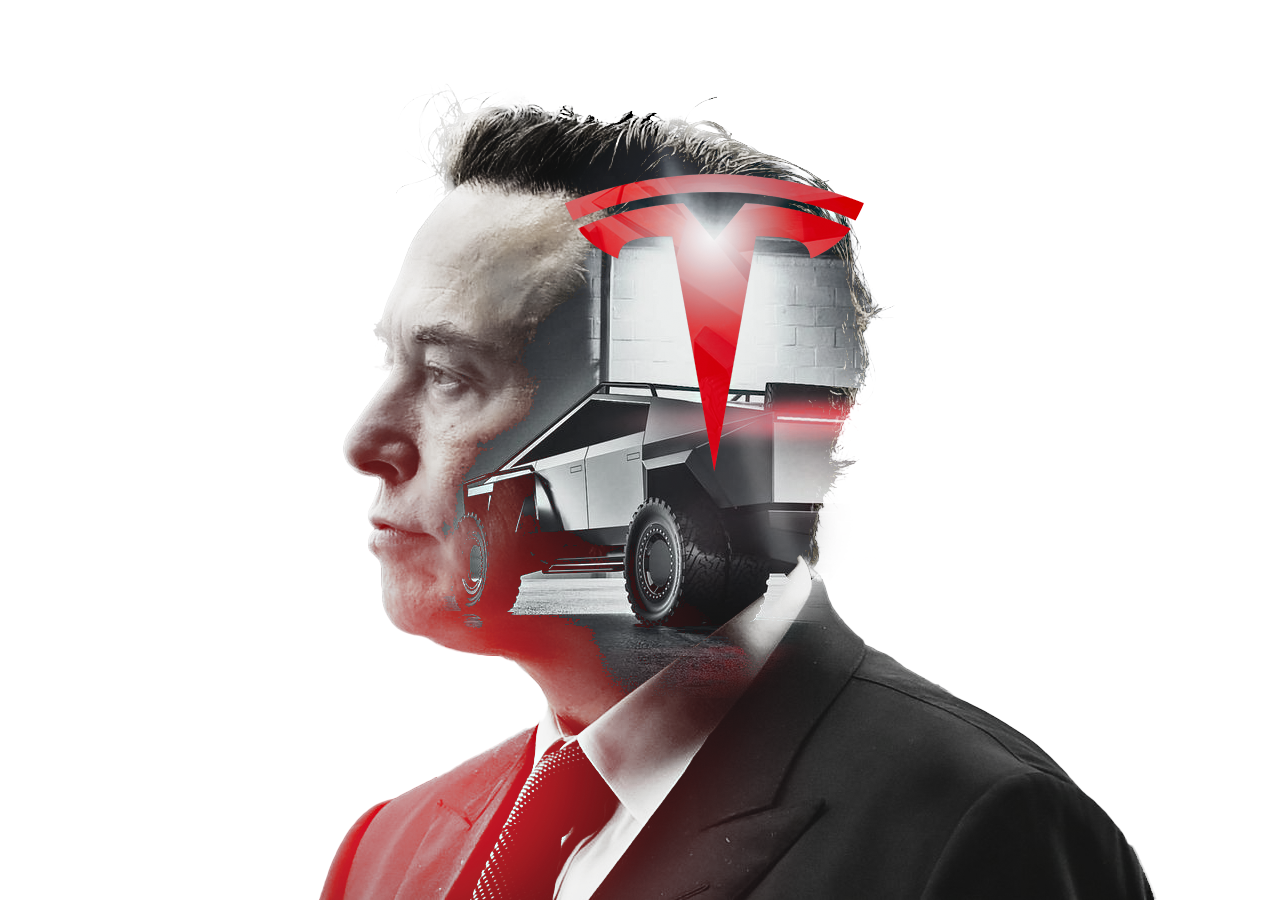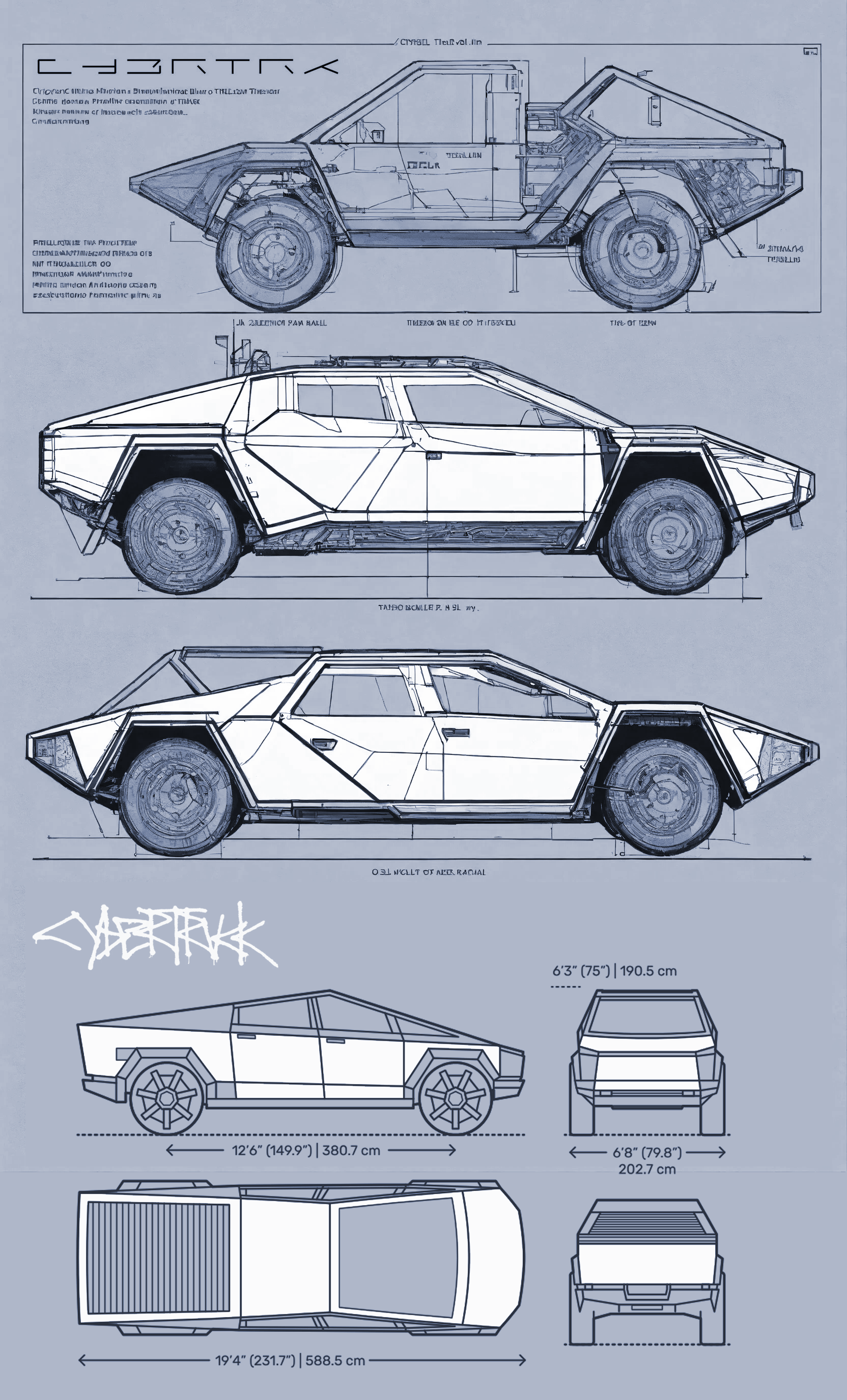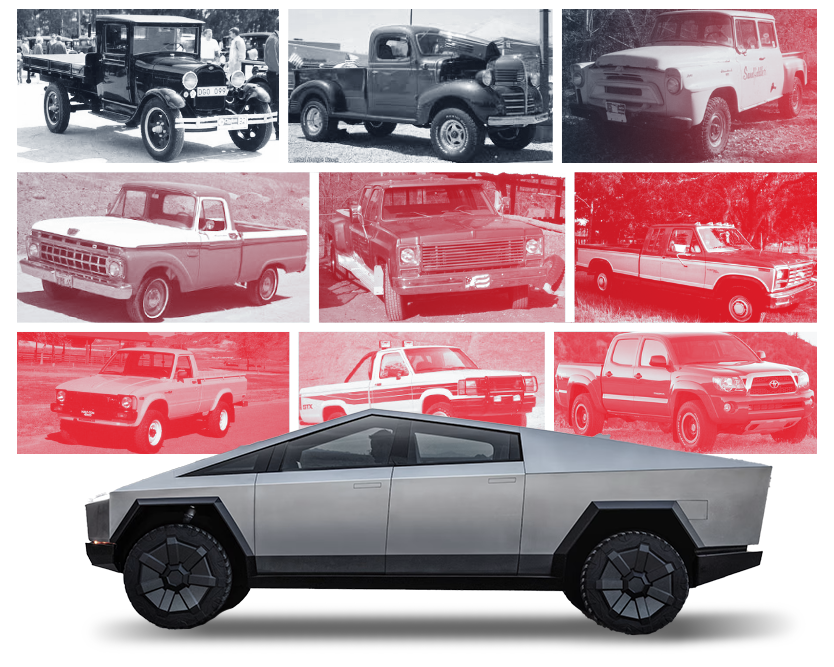Tesla's Cybertruck
Promises a Pickup Truck Design Revolution
In November 2019, Tesla founder Elon Musk unveiled the first pickup truck that his company will produce in Los Angeles. The unusual angular shape of the Cybertruck provoked thousands of jokes and memes; despite the barrage of criticism, Musk reported on November 26 that 250,000 people had pre-ordered the vehicle.
After several delays, the Tesla Cybertruck was finally released into production on November 30, 2023. It is offered in three models: Cyberbeast, All Wheel Drive, and Rear-Wheel Drive, with an EPA range of 250 to 340 miles (400-550 km) depending on the model.
One of the most noticeable aspects of the Cybertruck is its unique design. Made from stainless steel, it features sharp angles and straight lines, eliciting both positive and negative reviews. Some people consider it futuristic and bold, while others find it rugged and unappealing.

What makes Cybertruck unique
In addition to its design, the Cybertruck offers a range of unique features that set it apart from other electric pickups. Here are some of them:
- Armored Doors: Cybertruck doors are made of 3mm thick stainless steel and can withstand shots from weapons up to 9mm. This makes it one of the safest pickups on the market.
- Adjustable Suspension: The Cybertruck is equipped with electronic adaptive suspension, allowing the adjustment of ground clearance from 8 to 16 inches. This provides versatility, allowing it to be used both off-road and on city streets.
- Smart Features: Cybertruck comes with a variety of smart features such as autopilot, parking assistance system, and facial recognition. These features make it one of the most technologically advanced pickups on the market.
Form, equipment and materials of Elon Musk's super pickup
"The reason the Cybertruck is so rectangular is that you can't stamp ultra-hard 30X steel otherwise it breaks the stamping press. Even bending it requires very clever soft geometry in the fold—that's why prototype is faceted," Elon Musk wrote on Twitter, explaining why the team that worked on creating the pickup chose this shape.
However, the public also had other questions regarding not only the exterior of the Cybertruck: for example, how good the car is in terms of aerodynamics. It turned out that it is no worse than other pickups in this parameter. To show how the angular shape of the car affects its speed and maneuverability, the authors of the YouTube channel Boats and Engines simulated the behavior of the vehicle using a special program. They concluded that the air resistance coefficient of this machine is lower than that of the popular Ford F-150 and Dodge Ram 1500 pickups (however, the coefficients obtained from the Boats and Engines simulation differ from the figures claimed by the manufacturers of the aforementioned vehicles). Another expert, aerospace engineer Justin Martin, also analyzed the aerodynamic properties of the Cybertruck using simulation and came to similar conclusions.
In any case, all these experiments are just fantasy for now. Currently, the Cybertruck is more of a pickup concept, far from being introduced to the market. The vehicle lacks important elements that are necessary for it to actually be drivable. The model shown at the presentation did not have side mirrors, wipers or additional clearance lights - all these elements are necessary to sell the car in the US (although federal authorities are considering introducing a new law that will allow the use of cameras instead of side mirrors).
Tesla representatives have not yet commented on whether the design and equipment of the vehicle will change before the company launches it into production in 2021.

A bold design offered to a conservative audience
Matthew DeBord, senior correspondent at Business Insider covering the auto market and Tesla in particular, believes the Cybertruck is a real breakthrough for the company and Tesla’s chief designer Franz von Holzhausen.
Holzhausen joined Tesla in 2008, already being a well-known designer in the auto industry, and it was thanks to his efforts that the company managed to attract mass consumers. “[Tesla] Model S draws attention but does not demand it. For Holzhausen, this is a vision of the future that is clear to everyone,” DeBord wrote about Tesla’s first model released after the designer joined Musk’s startup. However, since 2012 Tesla has not released anything that could be called a design breakthrough - the Tesla Model X, Model 3 and Model Y models were a continuation of the direction set by the Model S.
The Cybertruck looks nothing like Tesla's previous models: its low-poly outlines are reminiscent of cars from science fiction movies and do not fit into the line of sleek sedans that Holzhausen created earlier.
What makes this pickup remarkable is that it offers bold styling to a conservative audience.
"No one can accuse the Cybertruck of being too grounded in the reality of the pickup truck market,"
DeBord comments. Dropbox Vice President of Product and Growth Adam Nash wrote: “I’m still not sure there’s overlap on a Venn diagram of ‘people who buy pickup trucks’ and ‘people who like the way this looks’ — but maybe that means they’re [Tesla] going to create a new market?”
If Tesla does try to reach the pickup truck buyer audience, the company will have to compete with market leaders whose customers are usually very loyal to their chosen brand: for example, Ford pickup buyers have a 70 percent chance of choosing the same brand when buying trucks again. According to Forbes estimates, the Cybertruck could bring Tesla over $4.5 billion in revenue by 2025; compared to market leader Ford, whose pickup truck revenue was about $25 billion in 2018, this is relatively small.
Tesla drew inspiration from science fiction and the 1980s
The Cybertruck is futuristic. Back in 2018, Musk told Kara Swisher, a journalist, that the pickup would be inspired by the movie Blade Runner. And indeed, the outlines of the vehicle resemble the "spinners" - flying police cars from Ridley Scott's famous movie. Syd Mead, the art director of Blade Runner who came up with these fantastic machines, approves of the Cybertruck design: “It completely changes the design language of the pickup truck market.”
Another source of inspiration for Musk, Holzhausen and the entire Tesla team is the iconic Warthog jeep from the popular Halo game series. Interestingly, just recently a Halo fan even recreated the cult vehicle based on a Chevrolet pickup! Obviously, the Cybertruck isn't a complete replica of the sci-fi machine, but the resemblance is strong enough to have caught the attention of game fans. For instance, famous YouTube blogger PewDiePie even declared his intention to buy the car because of its Warthog vibes.
Shortly after the release of the Cybertruck, the famous Italian design studio ItalDesign published photos of its old projects on Facebook with the caption: "Icons never cease to inspire us. Maybe you recently noticed some echoes of this legacy?" The ItalDesign studio is known for its "wedge-shaped" cars - cars of this shape began to appear in the 1960s and peaked in popularity in the 1970s and 1980s. This type of vehicle includes models such as the Alfa Romeo Carabo, Maserati Boomerang, BMW M1 and others.
One of the most striking examples of "wedge-shaped" design is the iconic Lotus Esprit S1 car created by ItalDesign co-founder Giorgetto Giugiaro. This model became another important reference for the Cybertruck design team. Notably, Musk first encountered the Lotus Esprit S1 as a child while watching the 1977 spy comedy The Spy Who Loved Me, the tenth James Bond film. It seems this early exposure left a lasting impression!
In 2013, Musk even bought one of the cars used in filming for $997,000. At the time, he also talked about his impressions of the film: “When I was a child growing up in South Africa, I was amazed at how James Bond in The Spy Who Loved Me drove his Lotus Esprit off a pier, pressed a button and it turned into a submarine underwater. I was disappointed to learn that it can’t actually transform. I’m going to make it so that an electric Tesla power train can enable cars to transform for real."
Although the Cybertruck will likely have to be modified for release in the US market, and Musk's plan to create a car-submarine has (so far) not materialized, many still see the Cybertruck as a revolution. Dave Chen, Adobe’s chief designer and former Tesla designer, tweeted:
“Whether you love it or hate it, your outlook on pickups will never be the same. Every pickup on the planet now looks old fashioned and tired. It’s a lesson in taking creative risks, building something unexpected and making a statement.”

Conclusion
In conclusion, despite the controversial public reaction, the extremely bold and futuristic design of the Tesla Cybertruck promises to become a real revolution in the pickup truck market.
The Tesla Cybertruck is an uncompromising vehicle, extremely controversial in terms of design, yet potentially revolutionary in terms of its technical characteristics and functionality.
The radical, overtly futuristic look of the Cybertruck came as a surprise to many and will likely remain a subject of discussion for a long time. But Elon Musk notes that innovation lies precisely in the audacity to offer something fundamentally different from traditional pickup trucks.
Even skeptics admit that behind the Cybertruck's unusual exterior lies outstanding functionality: a 1,900 kg payload capacity, 950 km range, 209 km/h top speed and a 2.9 second 0-100 km/h acceleration time. These are strong arguments for professionals. In addition, the rugged body and 3 mm steel doors provide safety.
Finally, the Cybertruck has a price advantage over its competitors, and electric propulsion is more economical than gasoline. All of this suggests that despite its appearance, this pickup will occupy an important place in the utility vehicle market and change notions of what makes a practical pickup, combining excellent working qualities and advanced technologies.
